M&S Operations: Examining Leadership, Management Roles and Impact
VerifiedAdded on 2023/01/07
|18
|5357
|80
Report
AI Summary
This report provides an analysis of leadership and management roles within Marks and Spencer (M&S), a British multinational retailer. It defines the roles and characteristics of leaders and managers, differentiating their functions in various organizational situations, and applying different models and theories to illustrate these roles. The report further explores key approaches to operational management, highlighting the importance of operational management and assessing the impact of business environment factors on operational processes and decision-making. It covers leadership styles such as transactional and transformational, and discusses management functions including planning, organization, directing, and controlling. Specific situations like conflict resolution and change implementation are examined to illustrate the roles of leaders and managers, and the application of management by objectives and chaos theory is also discussed. The report concludes by analyzing different leadership models like the situational system and contingency approach, providing a comprehensive overview of leadership and management in the context of M&S operations.
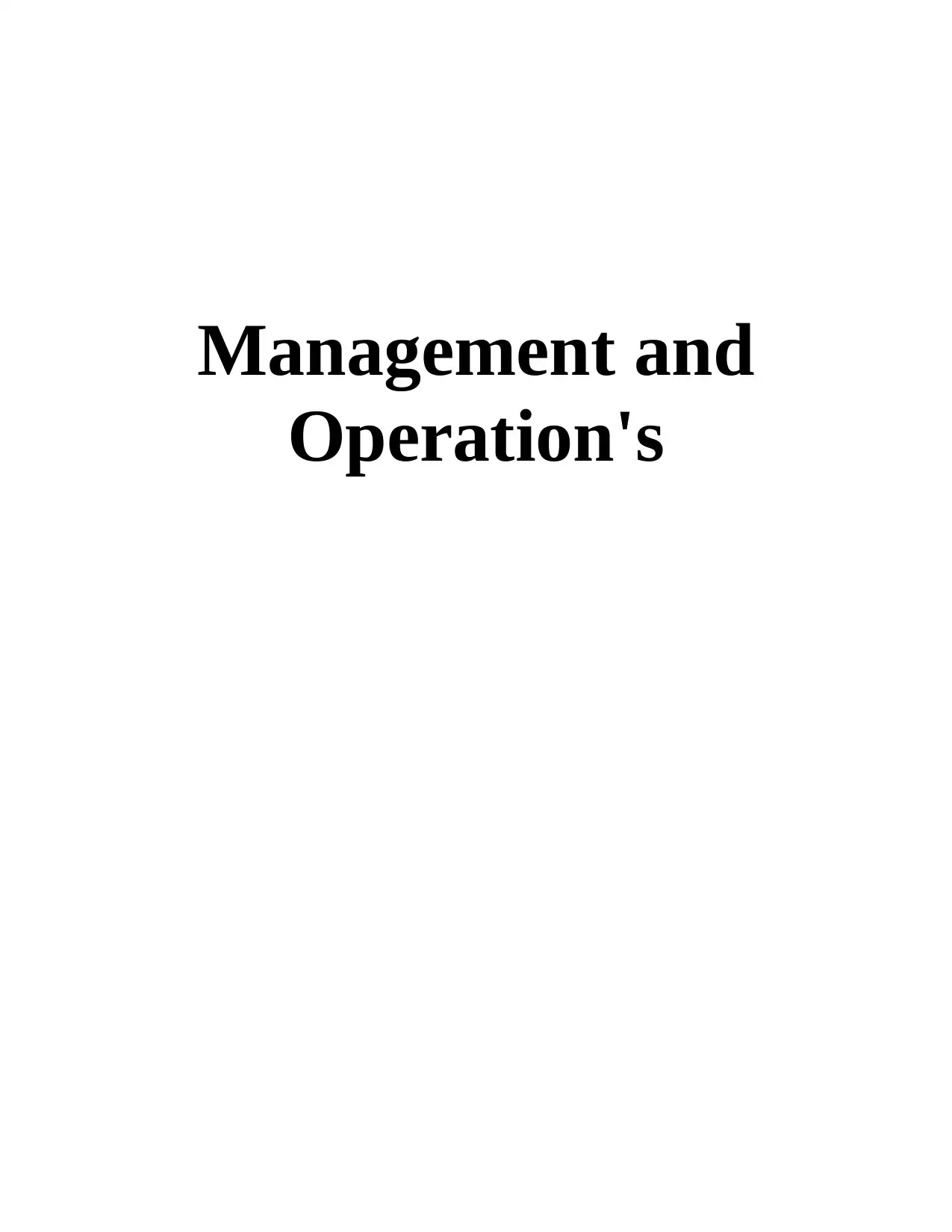
Management and
Operation's
Operation's
Paraphrase This Document
Need a fresh take? Get an instant paraphrase of this document with our AI Paraphraser
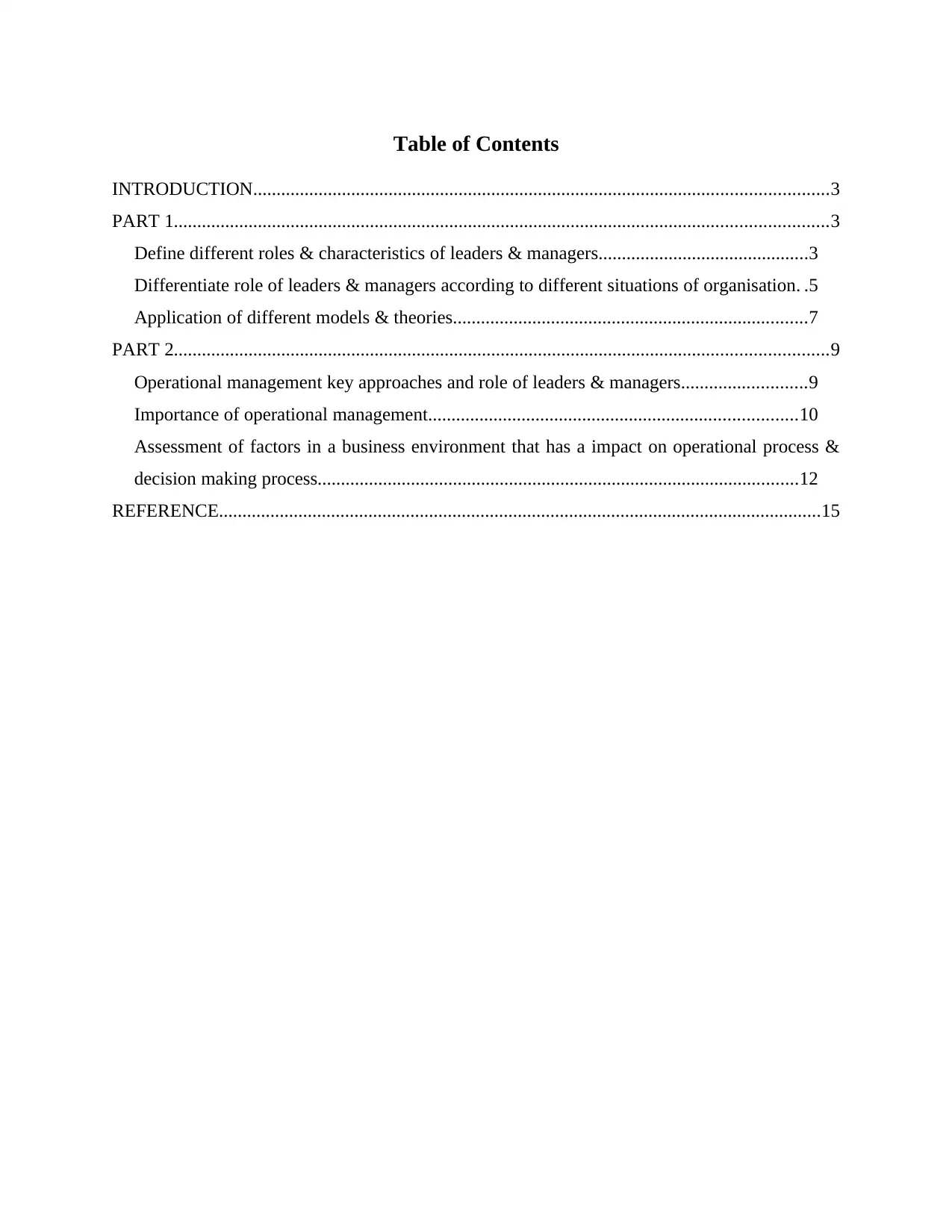
Table of Contents
INTRODUCTION...........................................................................................................................3
PART 1............................................................................................................................................3
Define different roles & characteristics of leaders & managers.............................................3
Differentiate role of leaders & managers according to different situations of organisation. .5
Application of different models & theories............................................................................7
PART 2............................................................................................................................................9
Operational management key approaches and role of leaders & managers...........................9
Importance of operational management...............................................................................10
Assessment of factors in a business environment that has a impact on operational process &
decision making process.......................................................................................................12
REFERENCE.................................................................................................................................15
INTRODUCTION...........................................................................................................................3
PART 1............................................................................................................................................3
Define different roles & characteristics of leaders & managers.............................................3
Differentiate role of leaders & managers according to different situations of organisation. .5
Application of different models & theories............................................................................7
PART 2............................................................................................................................................9
Operational management key approaches and role of leaders & managers...........................9
Importance of operational management...............................................................................10
Assessment of factors in a business environment that has a impact on operational process &
decision making process.......................................................................................................12
REFERENCE.................................................................................................................................15
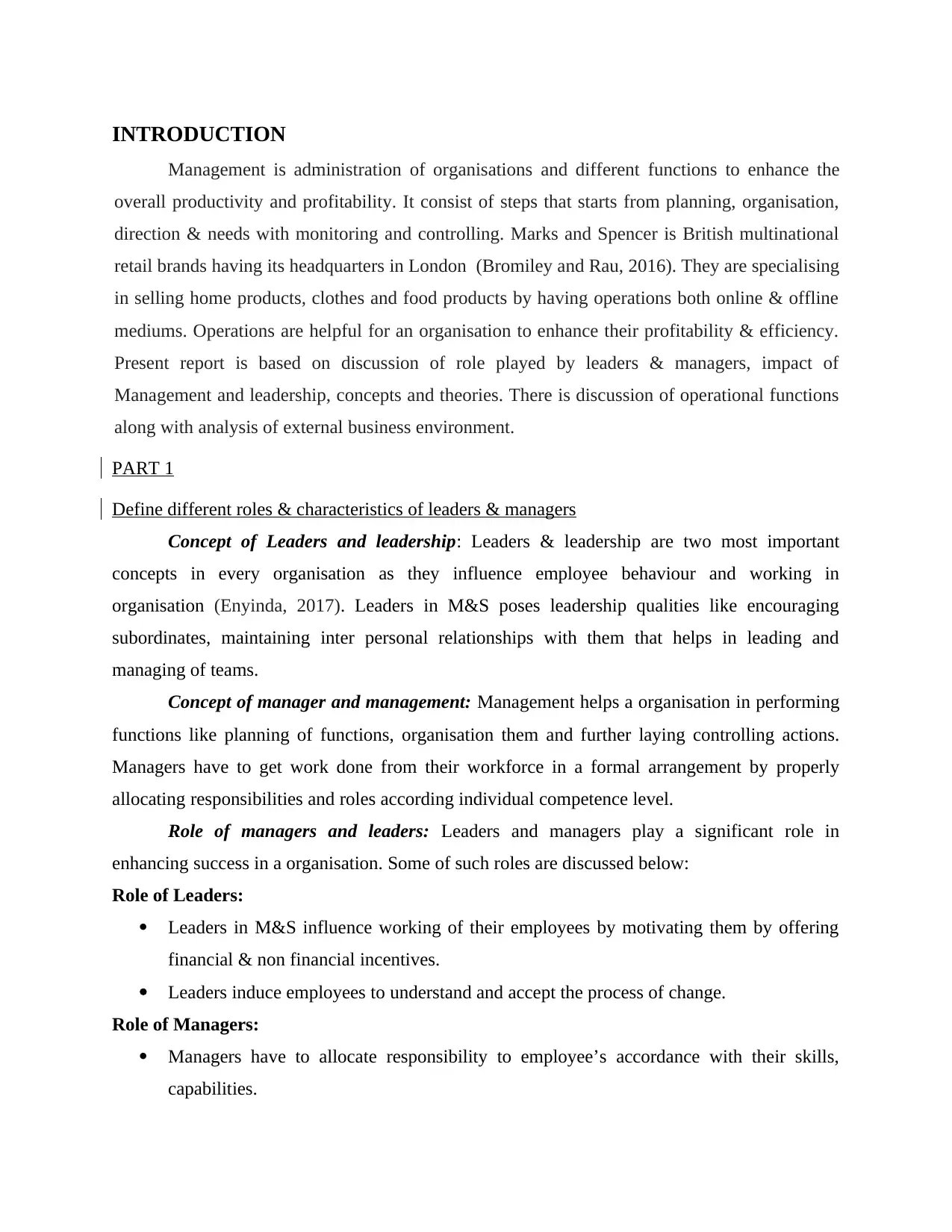
INTRODUCTION
Management is administration of organisations and different functions to enhance the
overall productivity and profitability. It consist of steps that starts from planning, organisation,
direction & needs with monitoring and controlling. Marks and Spencer is British multinational
retail brands having its headquarters in London (Bromiley and Rau, 2016). They are specialising
in selling home products, clothes and food products by having operations both online & offline
mediums. Operations are helpful for an organisation to enhance their profitability & efficiency.
Present report is based on discussion of role played by leaders & managers, impact of
Management and leadership, concepts and theories. There is discussion of operational functions
along with analysis of external business environment.
PART 1
Define different roles & characteristics of leaders & managers
Concept of Leaders and leadership: Leaders & leadership are two most important
concepts in every organisation as they influence employee behaviour and working in
organisation (Enyinda, 2017). Leaders in M&S poses leadership qualities like encouraging
subordinates, maintaining inter personal relationships with them that helps in leading and
managing of teams.
Concept of manager and management: Management helps a organisation in performing
functions like planning of functions, organisation them and further laying controlling actions.
Managers have to get work done from their workforce in a formal arrangement by properly
allocating responsibilities and roles according individual competence level.
Role of managers and leaders: Leaders and managers play a significant role in
enhancing success in a organisation. Some of such roles are discussed below:
Role of Leaders:
Leaders in M&S influence working of their employees by motivating them by offering
financial & non financial incentives.
Leaders induce employees to understand and accept the process of change.
Role of Managers:
Managers have to allocate responsibility to employee’s accordance with their skills,
capabilities.
Management is administration of organisations and different functions to enhance the
overall productivity and profitability. It consist of steps that starts from planning, organisation,
direction & needs with monitoring and controlling. Marks and Spencer is British multinational
retail brands having its headquarters in London (Bromiley and Rau, 2016). They are specialising
in selling home products, clothes and food products by having operations both online & offline
mediums. Operations are helpful for an organisation to enhance their profitability & efficiency.
Present report is based on discussion of role played by leaders & managers, impact of
Management and leadership, concepts and theories. There is discussion of operational functions
along with analysis of external business environment.
PART 1
Define different roles & characteristics of leaders & managers
Concept of Leaders and leadership: Leaders & leadership are two most important
concepts in every organisation as they influence employee behaviour and working in
organisation (Enyinda, 2017). Leaders in M&S poses leadership qualities like encouraging
subordinates, maintaining inter personal relationships with them that helps in leading and
managing of teams.
Concept of manager and management: Management helps a organisation in performing
functions like planning of functions, organisation them and further laying controlling actions.
Managers have to get work done from their workforce in a formal arrangement by properly
allocating responsibilities and roles according individual competence level.
Role of managers and leaders: Leaders and managers play a significant role in
enhancing success in a organisation. Some of such roles are discussed below:
Role of Leaders:
Leaders in M&S influence working of their employees by motivating them by offering
financial & non financial incentives.
Leaders induce employees to understand and accept the process of change.
Role of Managers:
Managers have to allocate responsibility to employee’s accordance with their skills,
capabilities.
⊘ This is a preview!⊘
Do you want full access?
Subscribe today to unlock all pages.

Trusted by 1+ million students worldwide
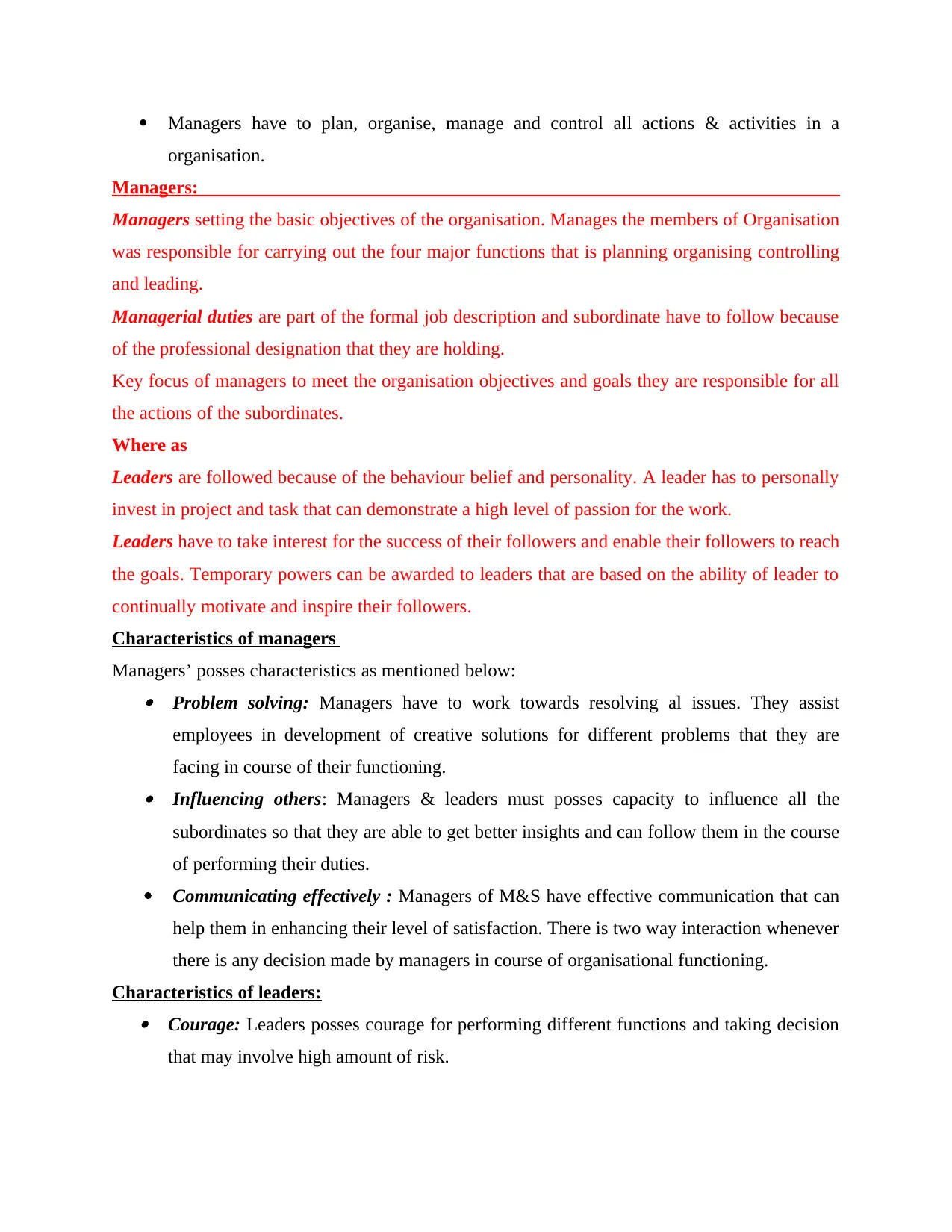
Managers have to plan, organise, manage and control all actions & activities in a
organisation.
Managers:
Managers setting the basic objectives of the organisation. Manages the members of Organisation
was responsible for carrying out the four major functions that is planning organising controlling
and leading.
Managerial duties are part of the formal job description and subordinate have to follow because
of the professional designation that they are holding.
Key focus of managers to meet the organisation objectives and goals they are responsible for all
the actions of the subordinates.
Where as
Leaders are followed because of the behaviour belief and personality. A leader has to personally
invest in project and task that can demonstrate a high level of passion for the work.
Leaders have to take interest for the success of their followers and enable their followers to reach
the goals. Temporary powers can be awarded to leaders that are based on the ability of leader to
continually motivate and inspire their followers.
Characteristics of managers
Managers’ posses characteristics as mentioned below: Problem solving: Managers have to work towards resolving al issues. They assist
employees in development of creative solutions for different problems that they are
facing in course of their functioning. Influencing others: Managers & leaders must posses capacity to influence all the
subordinates so that they are able to get better insights and can follow them in the course
of performing their duties.
Communicating effectively : Managers of M&S have effective communication that can
help them in enhancing their level of satisfaction. There is two way interaction whenever
there is any decision made by managers in course of organisational functioning.
Characteristics of leaders: Courage: Leaders posses courage for performing different functions and taking decision
that may involve high amount of risk.
organisation.
Managers:
Managers setting the basic objectives of the organisation. Manages the members of Organisation
was responsible for carrying out the four major functions that is planning organising controlling
and leading.
Managerial duties are part of the formal job description and subordinate have to follow because
of the professional designation that they are holding.
Key focus of managers to meet the organisation objectives and goals they are responsible for all
the actions of the subordinates.
Where as
Leaders are followed because of the behaviour belief and personality. A leader has to personally
invest in project and task that can demonstrate a high level of passion for the work.
Leaders have to take interest for the success of their followers and enable their followers to reach
the goals. Temporary powers can be awarded to leaders that are based on the ability of leader to
continually motivate and inspire their followers.
Characteristics of managers
Managers’ posses characteristics as mentioned below: Problem solving: Managers have to work towards resolving al issues. They assist
employees in development of creative solutions for different problems that they are
facing in course of their functioning. Influencing others: Managers & leaders must posses capacity to influence all the
subordinates so that they are able to get better insights and can follow them in the course
of performing their duties.
Communicating effectively : Managers of M&S have effective communication that can
help them in enhancing their level of satisfaction. There is two way interaction whenever
there is any decision made by managers in course of organisational functioning.
Characteristics of leaders: Courage: Leaders posses courage for performing different functions and taking decision
that may involve high amount of risk.
Paraphrase This Document
Need a fresh take? Get an instant paraphrase of this document with our AI Paraphraser
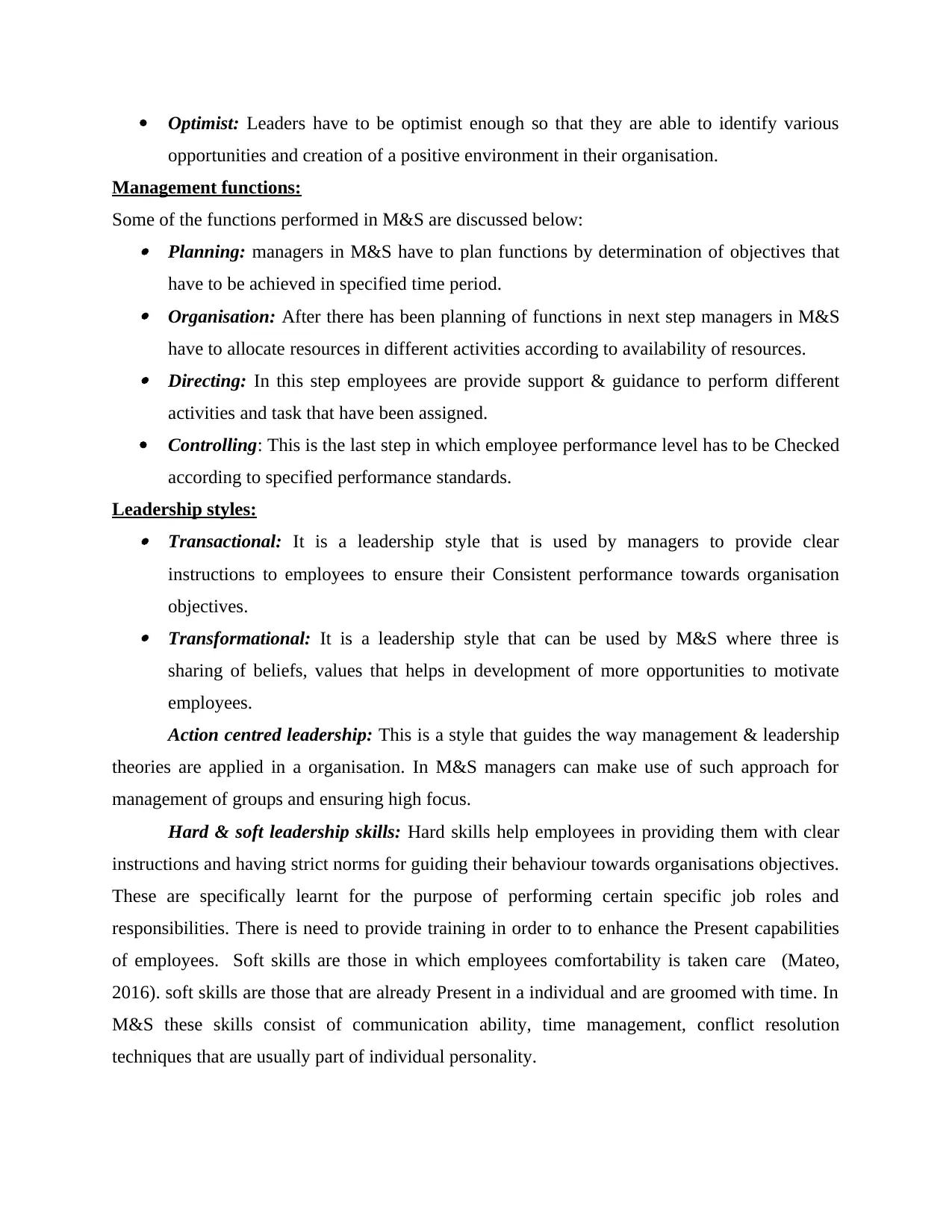
Optimist: Leaders have to be optimist enough so that they are able to identify various
opportunities and creation of a positive environment in their organisation.
Management functions:
Some of the functions performed in M&S are discussed below: Planning: managers in M&S have to plan functions by determination of objectives that
have to be achieved in specified time period. Organisation: After there has been planning of functions in next step managers in M&S
have to allocate resources in different activities according to availability of resources. Directing: In this step employees are provide support & guidance to perform different
activities and task that have been assigned.
Controlling: This is the last step in which employee performance level has to be Checked
according to specified performance standards.
Leadership styles: Transactional: It is a leadership style that is used by managers to provide clear
instructions to employees to ensure their Consistent performance towards organisation
objectives. Transformational: It is a leadership style that can be used by M&S where three is
sharing of beliefs, values that helps in development of more opportunities to motivate
employees.
Action centred leadership: This is a style that guides the way management & leadership
theories are applied in a organisation. In M&S managers can make use of such approach for
management of groups and ensuring high focus.
Hard & soft leadership skills: Hard skills help employees in providing them with clear
instructions and having strict norms for guiding their behaviour towards organisations objectives.
These are specifically learnt for the purpose of performing certain specific job roles and
responsibilities. There is need to provide training in order to to enhance the Present capabilities
of employees. Soft skills are those in which employees comfortability is taken care (Mateo,
2016). soft skills are those that are already Present in a individual and are groomed with time. In
M&S these skills consist of communication ability, time management, conflict resolution
techniques that are usually part of individual personality.
opportunities and creation of a positive environment in their organisation.
Management functions:
Some of the functions performed in M&S are discussed below: Planning: managers in M&S have to plan functions by determination of objectives that
have to be achieved in specified time period. Organisation: After there has been planning of functions in next step managers in M&S
have to allocate resources in different activities according to availability of resources. Directing: In this step employees are provide support & guidance to perform different
activities and task that have been assigned.
Controlling: This is the last step in which employee performance level has to be Checked
according to specified performance standards.
Leadership styles: Transactional: It is a leadership style that is used by managers to provide clear
instructions to employees to ensure their Consistent performance towards organisation
objectives. Transformational: It is a leadership style that can be used by M&S where three is
sharing of beliefs, values that helps in development of more opportunities to motivate
employees.
Action centred leadership: This is a style that guides the way management & leadership
theories are applied in a organisation. In M&S managers can make use of such approach for
management of groups and ensuring high focus.
Hard & soft leadership skills: Hard skills help employees in providing them with clear
instructions and having strict norms for guiding their behaviour towards organisations objectives.
These are specifically learnt for the purpose of performing certain specific job roles and
responsibilities. There is need to provide training in order to to enhance the Present capabilities
of employees. Soft skills are those in which employees comfortability is taken care (Mateo,
2016). soft skills are those that are already Present in a individual and are groomed with time. In
M&S these skills consist of communication ability, time management, conflict resolution
techniques that are usually part of individual personality.
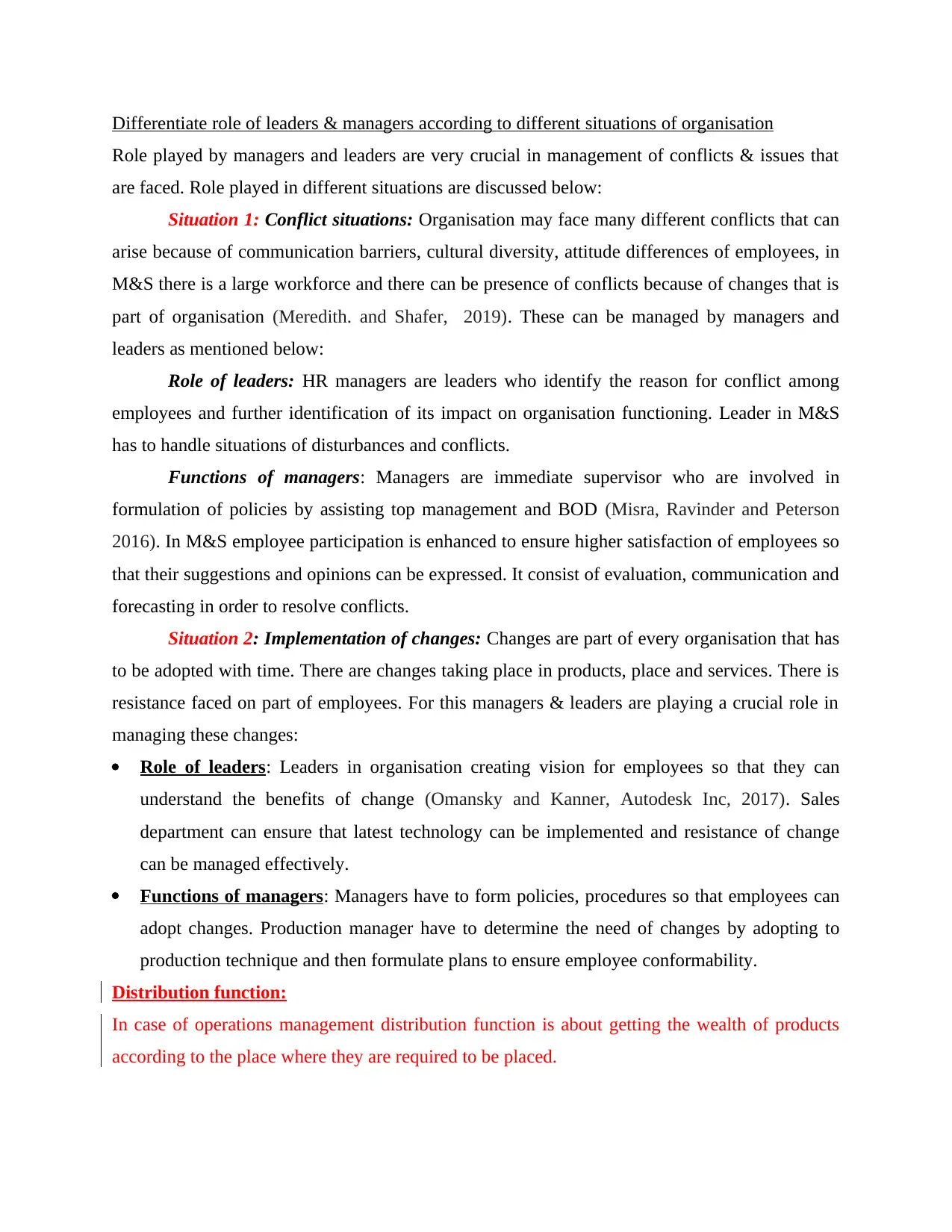
Differentiate role of leaders & managers according to different situations of organisation
Role played by managers and leaders are very crucial in management of conflicts & issues that
are faced. Role played in different situations are discussed below:
Situation 1: Conflict situations: Organisation may face many different conflicts that can
arise because of communication barriers, cultural diversity, attitude differences of employees, in
M&S there is a large workforce and there can be presence of conflicts because of changes that is
part of organisation (Meredith. and Shafer, 2019). These can be managed by managers and
leaders as mentioned below:
Role of leaders: HR managers are leaders who identify the reason for conflict among
employees and further identification of its impact on organisation functioning. Leader in M&S
has to handle situations of disturbances and conflicts.
Functions of managers: Managers are immediate supervisor who are involved in
formulation of policies by assisting top management and BOD (Misra, Ravinder and Peterson
2016). In M&S employee participation is enhanced to ensure higher satisfaction of employees so
that their suggestions and opinions can be expressed. It consist of evaluation, communication and
forecasting in order to resolve conflicts.
Situation 2: Implementation of changes: Changes are part of every organisation that has
to be adopted with time. There are changes taking place in products, place and services. There is
resistance faced on part of employees. For this managers & leaders are playing a crucial role in
managing these changes:
Role of leaders: Leaders in organisation creating vision for employees so that they can
understand the benefits of change (Omansky and Kanner, Autodesk Inc, 2017). Sales
department can ensure that latest technology can be implemented and resistance of change
can be managed effectively.
Functions of managers: Managers have to form policies, procedures so that employees can
adopt changes. Production manager have to determine the need of changes by adopting to
production technique and then formulate plans to ensure employee conformability.
Distribution function:
In case of operations management distribution function is about getting the wealth of products
according to the place where they are required to be placed.
Role played by managers and leaders are very crucial in management of conflicts & issues that
are faced. Role played in different situations are discussed below:
Situation 1: Conflict situations: Organisation may face many different conflicts that can
arise because of communication barriers, cultural diversity, attitude differences of employees, in
M&S there is a large workforce and there can be presence of conflicts because of changes that is
part of organisation (Meredith. and Shafer, 2019). These can be managed by managers and
leaders as mentioned below:
Role of leaders: HR managers are leaders who identify the reason for conflict among
employees and further identification of its impact on organisation functioning. Leader in M&S
has to handle situations of disturbances and conflicts.
Functions of managers: Managers are immediate supervisor who are involved in
formulation of policies by assisting top management and BOD (Misra, Ravinder and Peterson
2016). In M&S employee participation is enhanced to ensure higher satisfaction of employees so
that their suggestions and opinions can be expressed. It consist of evaluation, communication and
forecasting in order to resolve conflicts.
Situation 2: Implementation of changes: Changes are part of every organisation that has
to be adopted with time. There are changes taking place in products, place and services. There is
resistance faced on part of employees. For this managers & leaders are playing a crucial role in
managing these changes:
Role of leaders: Leaders in organisation creating vision for employees so that they can
understand the benefits of change (Omansky and Kanner, Autodesk Inc, 2017). Sales
department can ensure that latest technology can be implemented and resistance of change
can be managed effectively.
Functions of managers: Managers have to form policies, procedures so that employees can
adopt changes. Production manager have to determine the need of changes by adopting to
production technique and then formulate plans to ensure employee conformability.
Distribution function:
In case of operations management distribution function is about getting the wealth of products
according to the place where they are required to be placed.
⊘ This is a preview!⊘
Do you want full access?
Subscribe today to unlock all pages.

Trusted by 1+ million students worldwide
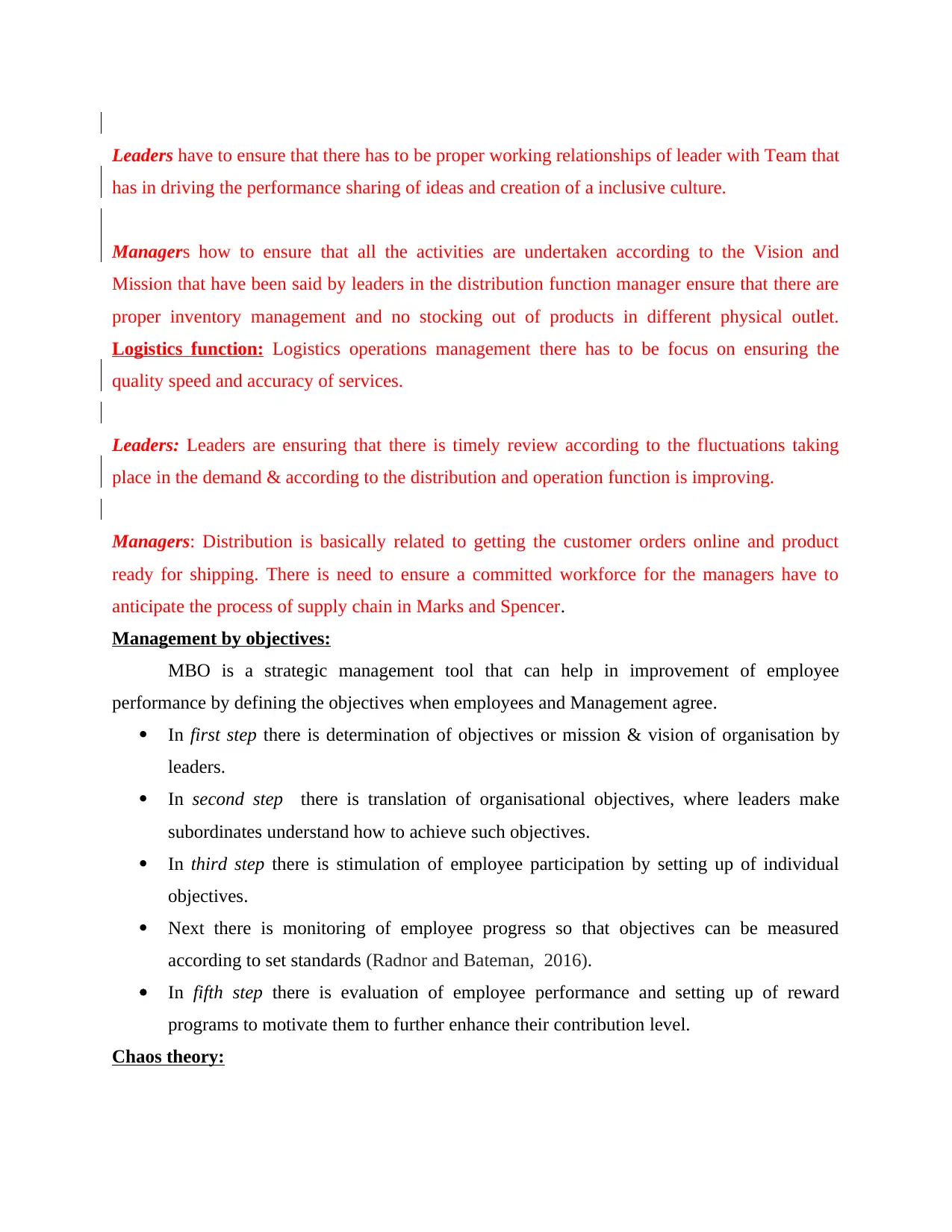
Leaders have to ensure that there has to be proper working relationships of leader with Team that
has in driving the performance sharing of ideas and creation of a inclusive culture.
Managers how to ensure that all the activities are undertaken according to the Vision and
Mission that have been said by leaders in the distribution function manager ensure that there are
proper inventory management and no stocking out of products in different physical outlet.
Logistics function: Logistics operations management there has to be focus on ensuring the
quality speed and accuracy of services.
Leaders: Leaders are ensuring that there is timely review according to the fluctuations taking
place in the demand & according to the distribution and operation function is improving.
Managers: Distribution is basically related to getting the customer orders online and product
ready for shipping. There is need to ensure a committed workforce for the managers have to
anticipate the process of supply chain in Marks and Spencer.
Management by objectives:
MBO is a strategic management tool that can help in improvement of employee
performance by defining the objectives when employees and Management agree.
In first step there is determination of objectives or mission & vision of organisation by
leaders.
In second step there is translation of organisational objectives, where leaders make
subordinates understand how to achieve such objectives.
In third step there is stimulation of employee participation by setting up of individual
objectives.
Next there is monitoring of employee progress so that objectives can be measured
according to set standards (Radnor and Bateman, 2016).
In fifth step there is evaluation of employee performance and setting up of reward
programs to motivate them to further enhance their contribution level.
Chaos theory:
has in driving the performance sharing of ideas and creation of a inclusive culture.
Managers how to ensure that all the activities are undertaken according to the Vision and
Mission that have been said by leaders in the distribution function manager ensure that there are
proper inventory management and no stocking out of products in different physical outlet.
Logistics function: Logistics operations management there has to be focus on ensuring the
quality speed and accuracy of services.
Leaders: Leaders are ensuring that there is timely review according to the fluctuations taking
place in the demand & according to the distribution and operation function is improving.
Managers: Distribution is basically related to getting the customer orders online and product
ready for shipping. There is need to ensure a committed workforce for the managers have to
anticipate the process of supply chain in Marks and Spencer.
Management by objectives:
MBO is a strategic management tool that can help in improvement of employee
performance by defining the objectives when employees and Management agree.
In first step there is determination of objectives or mission & vision of organisation by
leaders.
In second step there is translation of organisational objectives, where leaders make
subordinates understand how to achieve such objectives.
In third step there is stimulation of employee participation by setting up of individual
objectives.
Next there is monitoring of employee progress so that objectives can be measured
according to set standards (Radnor and Bateman, 2016).
In fifth step there is evaluation of employee performance and setting up of reward
programs to motivate them to further enhance their contribution level.
Chaos theory:
Paraphrase This Document
Need a fresh take? Get an instant paraphrase of this document with our AI Paraphraser
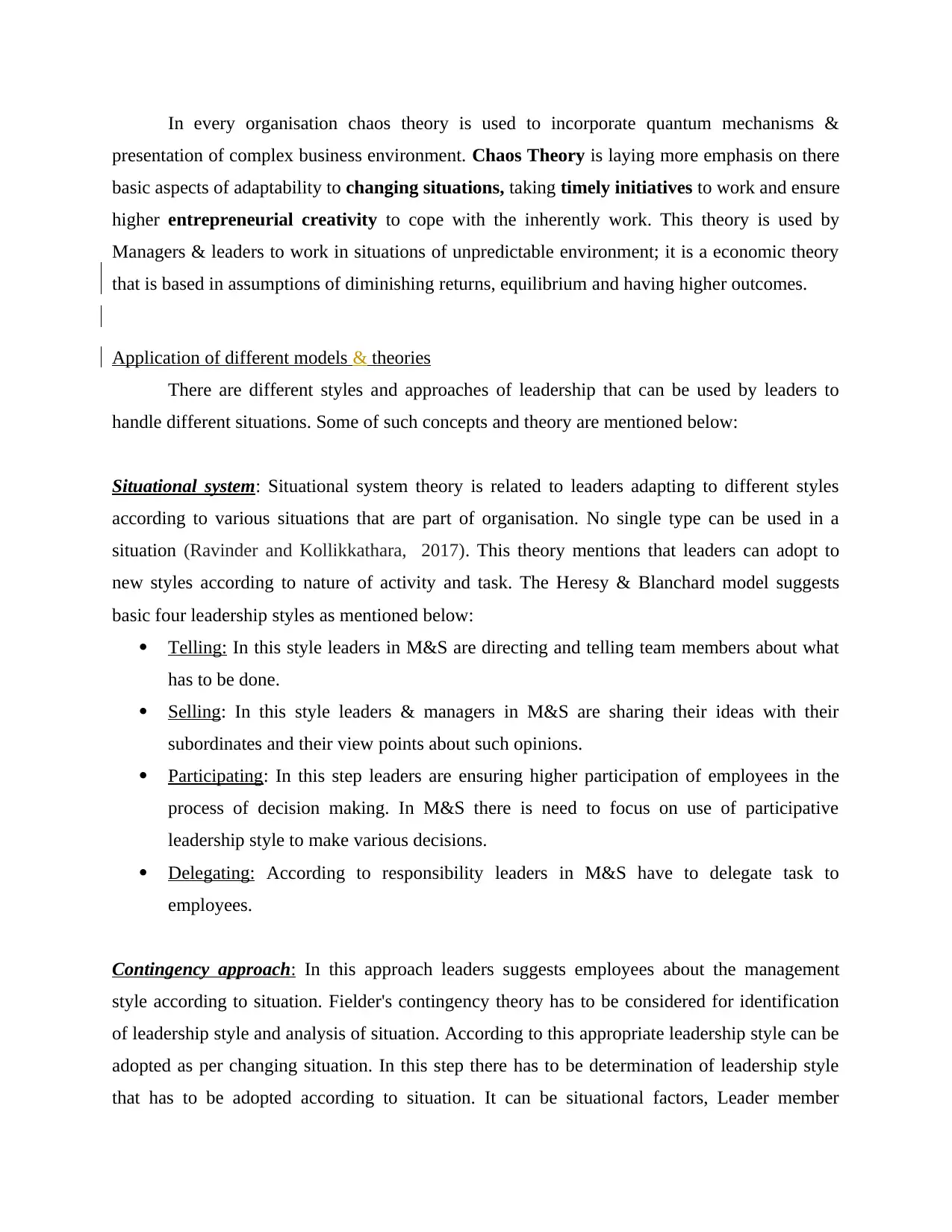
In every organisation chaos theory is used to incorporate quantum mechanisms &
presentation of complex business environment. Chaos Theory is laying more emphasis on there
basic aspects of adaptability to changing situations, taking timely initiatives to work and ensure
higher entrepreneurial creativity to cope with the inherently work. This theory is used by
Managers & leaders to work in situations of unpredictable environment; it is a economic theory
that is based in assumptions of diminishing returns, equilibrium and having higher outcomes.
Application of different models & theories
There are different styles and approaches of leadership that can be used by leaders to
handle different situations. Some of such concepts and theory are mentioned below:
Situational system: Situational system theory is related to leaders adapting to different styles
according to various situations that are part of organisation. No single type can be used in a
situation (Ravinder and Kollikkathara, 2017). This theory mentions that leaders can adopt to
new styles according to nature of activity and task. The Heresy & Blanchard model suggests
basic four leadership styles as mentioned below:
Telling: In this style leaders in M&S are directing and telling team members about what
has to be done.
Selling: In this style leaders & managers in M&S are sharing their ideas with their
subordinates and their view points about such opinions.
Participating: In this step leaders are ensuring higher participation of employees in the
process of decision making. In M&S there is need to focus on use of participative
leadership style to make various decisions.
Delegating: According to responsibility leaders in M&S have to delegate task to
employees.
Contingency approach: In this approach leaders suggests employees about the management
style according to situation. Fielder's contingency theory has to be considered for identification
of leadership style and analysis of situation. According to this appropriate leadership style can be
adopted as per changing situation. In this step there has to be determination of leadership style
that has to be adopted according to situation. It can be situational factors, Leader member
presentation of complex business environment. Chaos Theory is laying more emphasis on there
basic aspects of adaptability to changing situations, taking timely initiatives to work and ensure
higher entrepreneurial creativity to cope with the inherently work. This theory is used by
Managers & leaders to work in situations of unpredictable environment; it is a economic theory
that is based in assumptions of diminishing returns, equilibrium and having higher outcomes.
Application of different models & theories
There are different styles and approaches of leadership that can be used by leaders to
handle different situations. Some of such concepts and theory are mentioned below:
Situational system: Situational system theory is related to leaders adapting to different styles
according to various situations that are part of organisation. No single type can be used in a
situation (Ravinder and Kollikkathara, 2017). This theory mentions that leaders can adopt to
new styles according to nature of activity and task. The Heresy & Blanchard model suggests
basic four leadership styles as mentioned below:
Telling: In this style leaders in M&S are directing and telling team members about what
has to be done.
Selling: In this style leaders & managers in M&S are sharing their ideas with their
subordinates and their view points about such opinions.
Participating: In this step leaders are ensuring higher participation of employees in the
process of decision making. In M&S there is need to focus on use of participative
leadership style to make various decisions.
Delegating: According to responsibility leaders in M&S have to delegate task to
employees.
Contingency approach: In this approach leaders suggests employees about the management
style according to situation. Fielder's contingency theory has to be considered for identification
of leadership style and analysis of situation. According to this appropriate leadership style can be
adopted as per changing situation. In this step there has to be determination of leadership style
that has to be adopted according to situation. It can be situational factors, Leader member
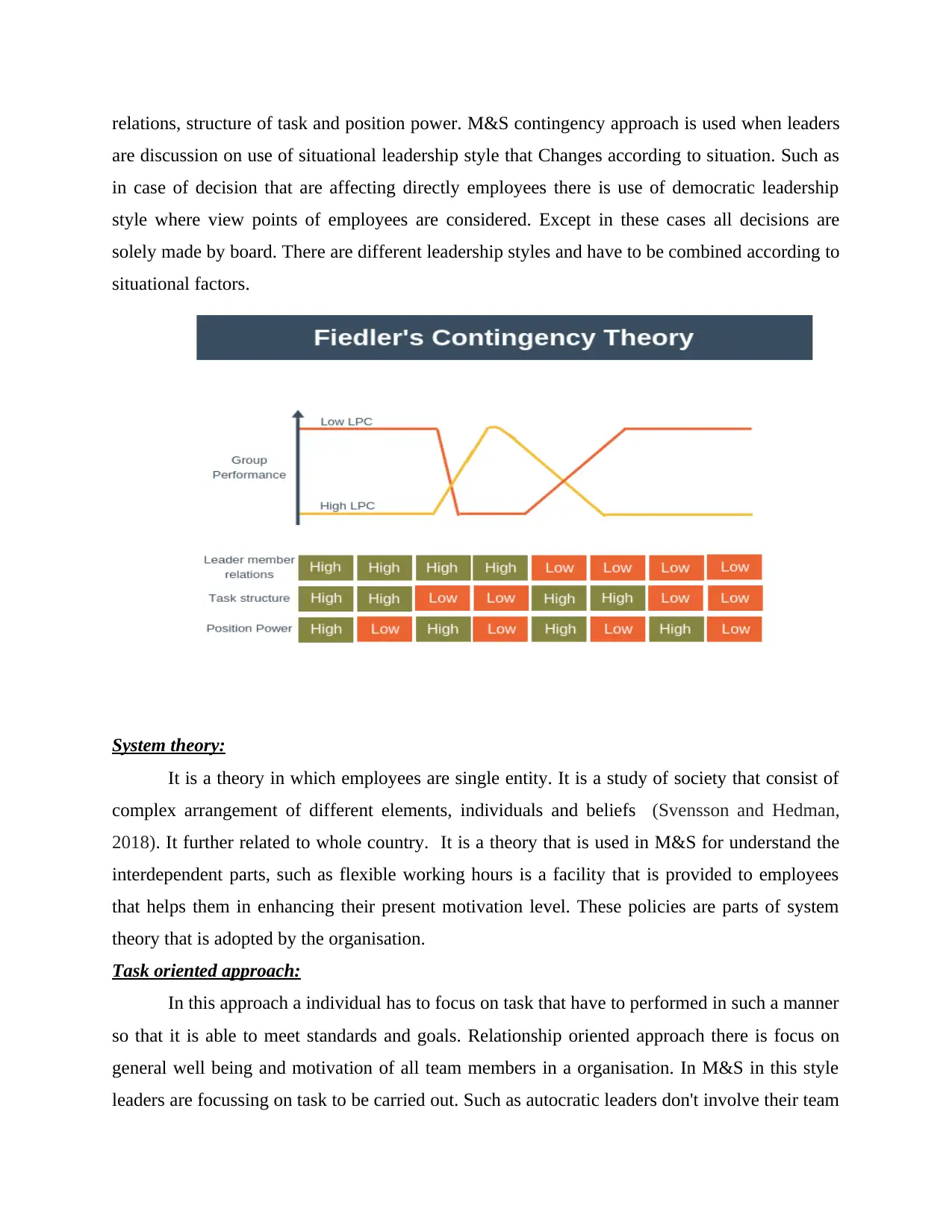
relations, structure of task and position power. M&S contingency approach is used when leaders
are discussion on use of situational leadership style that Changes according to situation. Such as
in case of decision that are affecting directly employees there is use of democratic leadership
style where view points of employees are considered. Except in these cases all decisions are
solely made by board. There are different leadership styles and have to be combined according to
situational factors.
System theory:
It is a theory in which employees are single entity. It is a study of society that consist of
complex arrangement of different elements, individuals and beliefs (Svensson and Hedman,
2018). It further related to whole country. It is a theory that is used in M&S for understand the
interdependent parts, such as flexible working hours is a facility that is provided to employees
that helps them in enhancing their present motivation level. These policies are parts of system
theory that is adopted by the organisation.
Task oriented approach:
In this approach a individual has to focus on task that have to performed in such a manner
so that it is able to meet standards and goals. Relationship oriented approach there is focus on
general well being and motivation of all team members in a organisation. In M&S in this style
leaders are focussing on task to be carried out. Such as autocratic leaders don't involve their team
are discussion on use of situational leadership style that Changes according to situation. Such as
in case of decision that are affecting directly employees there is use of democratic leadership
style where view points of employees are considered. Except in these cases all decisions are
solely made by board. There are different leadership styles and have to be combined according to
situational factors.
System theory:
It is a theory in which employees are single entity. It is a study of society that consist of
complex arrangement of different elements, individuals and beliefs (Svensson and Hedman,
2018). It further related to whole country. It is a theory that is used in M&S for understand the
interdependent parts, such as flexible working hours is a facility that is provided to employees
that helps them in enhancing their present motivation level. These policies are parts of system
theory that is adopted by the organisation.
Task oriented approach:
In this approach a individual has to focus on task that have to performed in such a manner
so that it is able to meet standards and goals. Relationship oriented approach there is focus on
general well being and motivation of all team members in a organisation. In M&S in this style
leaders are focussing on task to be carried out. Such as autocratic leaders don't involve their team
⊘ This is a preview!⊘
Do you want full access?
Subscribe today to unlock all pages.

Trusted by 1+ million students worldwide
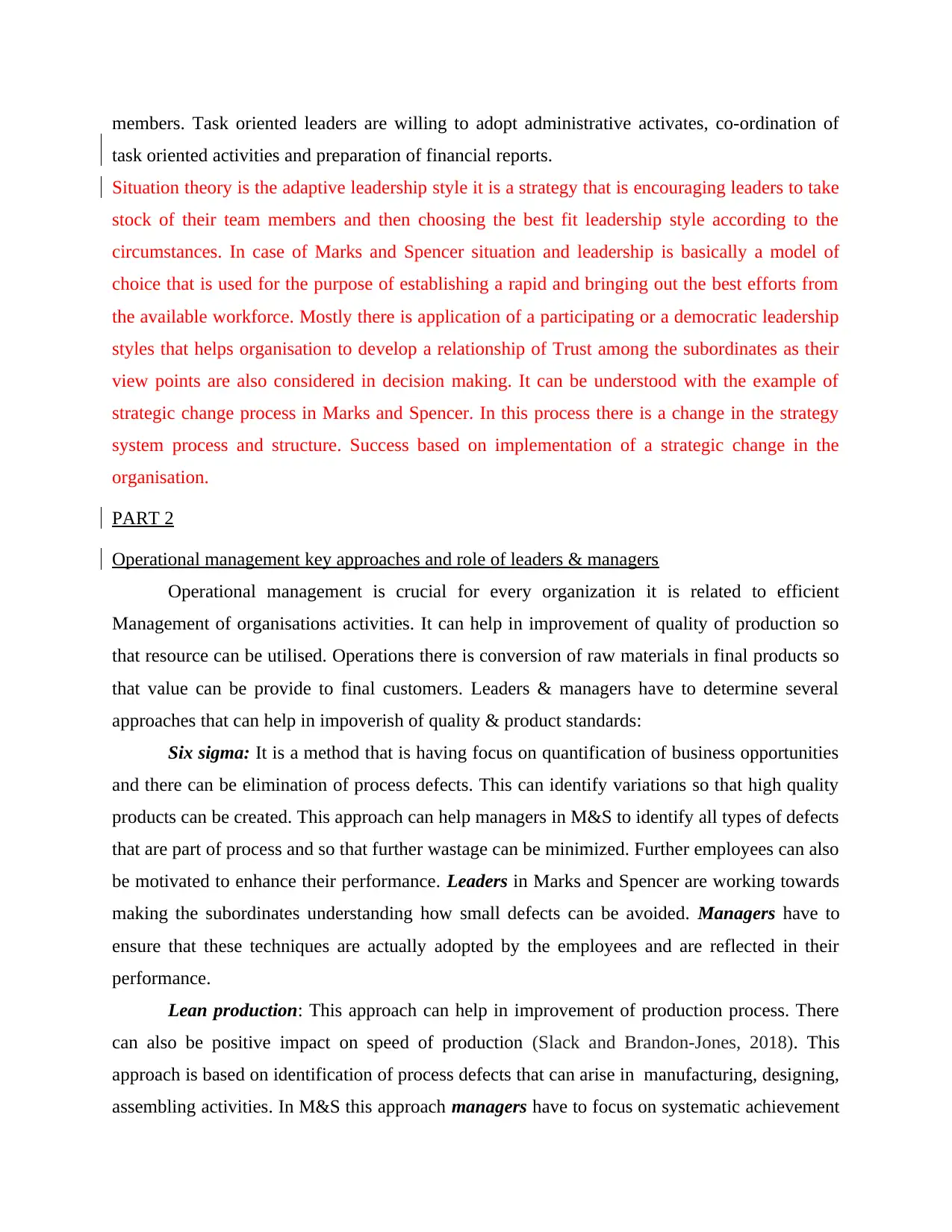
members. Task oriented leaders are willing to adopt administrative activates, co-ordination of
task oriented activities and preparation of financial reports.
Situation theory is the adaptive leadership style it is a strategy that is encouraging leaders to take
stock of their team members and then choosing the best fit leadership style according to the
circumstances. In case of Marks and Spencer situation and leadership is basically a model of
choice that is used for the purpose of establishing a rapid and bringing out the best efforts from
the available workforce. Mostly there is application of a participating or a democratic leadership
styles that helps organisation to develop a relationship of Trust among the subordinates as their
view points are also considered in decision making. It can be understood with the example of
strategic change process in Marks and Spencer. In this process there is a change in the strategy
system process and structure. Success based on implementation of a strategic change in the
organisation.
PART 2
Operational management key approaches and role of leaders & managers
Operational management is crucial for every organization it is related to efficient
Management of organisations activities. It can help in improvement of quality of production so
that resource can be utilised. Operations there is conversion of raw materials in final products so
that value can be provide to final customers. Leaders & managers have to determine several
approaches that can help in impoverish of quality & product standards:
Six sigma: It is a method that is having focus on quantification of business opportunities
and there can be elimination of process defects. This can identify variations so that high quality
products can be created. This approach can help managers in M&S to identify all types of defects
that are part of process and so that further wastage can be minimized. Further employees can also
be motivated to enhance their performance. Leaders in Marks and Spencer are working towards
making the subordinates understanding how small defects can be avoided. Managers have to
ensure that these techniques are actually adopted by the employees and are reflected in their
performance.
Lean production: This approach can help in improvement of production process. There
can also be positive impact on speed of production (Slack and Brandon-Jones, 2018). This
approach is based on identification of process defects that can arise in manufacturing, designing,
assembling activities. In M&S this approach managers have to focus on systematic achievement
task oriented activities and preparation of financial reports.
Situation theory is the adaptive leadership style it is a strategy that is encouraging leaders to take
stock of their team members and then choosing the best fit leadership style according to the
circumstances. In case of Marks and Spencer situation and leadership is basically a model of
choice that is used for the purpose of establishing a rapid and bringing out the best efforts from
the available workforce. Mostly there is application of a participating or a democratic leadership
styles that helps organisation to develop a relationship of Trust among the subordinates as their
view points are also considered in decision making. It can be understood with the example of
strategic change process in Marks and Spencer. In this process there is a change in the strategy
system process and structure. Success based on implementation of a strategic change in the
organisation.
PART 2
Operational management key approaches and role of leaders & managers
Operational management is crucial for every organization it is related to efficient
Management of organisations activities. It can help in improvement of quality of production so
that resource can be utilised. Operations there is conversion of raw materials in final products so
that value can be provide to final customers. Leaders & managers have to determine several
approaches that can help in impoverish of quality & product standards:
Six sigma: It is a method that is having focus on quantification of business opportunities
and there can be elimination of process defects. This can identify variations so that high quality
products can be created. This approach can help managers in M&S to identify all types of defects
that are part of process and so that further wastage can be minimized. Further employees can also
be motivated to enhance their performance. Leaders in Marks and Spencer are working towards
making the subordinates understanding how small defects can be avoided. Managers have to
ensure that these techniques are actually adopted by the employees and are reflected in their
performance.
Lean production: This approach can help in improvement of production process. There
can also be positive impact on speed of production (Slack and Brandon-Jones, 2018). This
approach is based on identification of process defects that can arise in manufacturing, designing,
assembling activities. In M&S this approach managers have to focus on systematic achievement
Paraphrase This Document
Need a fresh take? Get an instant paraphrase of this document with our AI Paraphraser
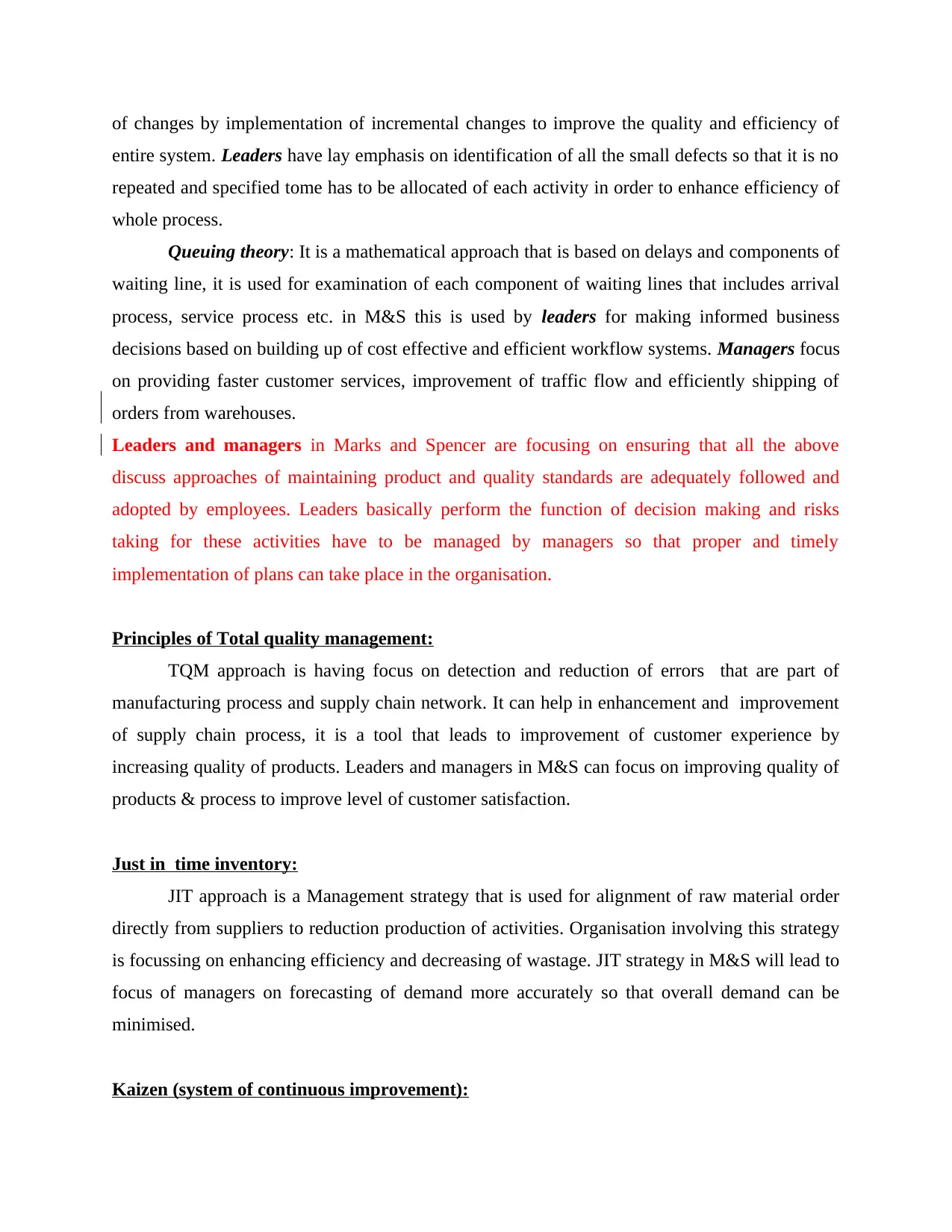
of changes by implementation of incremental changes to improve the quality and efficiency of
entire system. Leaders have lay emphasis on identification of all the small defects so that it is no
repeated and specified tome has to be allocated of each activity in order to enhance efficiency of
whole process.
Queuing theory: It is a mathematical approach that is based on delays and components of
waiting line, it is used for examination of each component of waiting lines that includes arrival
process, service process etc. in M&S this is used by leaders for making informed business
decisions based on building up of cost effective and efficient workflow systems. Managers focus
on providing faster customer services, improvement of traffic flow and efficiently shipping of
orders from warehouses.
Leaders and managers in Marks and Spencer are focusing on ensuring that all the above
discuss approaches of maintaining product and quality standards are adequately followed and
adopted by employees. Leaders basically perform the function of decision making and risks
taking for these activities have to be managed by managers so that proper and timely
implementation of plans can take place in the organisation.
Principles of Total quality management:
TQM approach is having focus on detection and reduction of errors that are part of
manufacturing process and supply chain network. It can help in enhancement and improvement
of supply chain process, it is a tool that leads to improvement of customer experience by
increasing quality of products. Leaders and managers in M&S can focus on improving quality of
products & process to improve level of customer satisfaction.
Just in time inventory:
JIT approach is a Management strategy that is used for alignment of raw material order
directly from suppliers to reduction production of activities. Organisation involving this strategy
is focussing on enhancing efficiency and decreasing of wastage. JIT strategy in M&S will lead to
focus of managers on forecasting of demand more accurately so that overall demand can be
minimised.
Kaizen (system of continuous improvement):
entire system. Leaders have lay emphasis on identification of all the small defects so that it is no
repeated and specified tome has to be allocated of each activity in order to enhance efficiency of
whole process.
Queuing theory: It is a mathematical approach that is based on delays and components of
waiting line, it is used for examination of each component of waiting lines that includes arrival
process, service process etc. in M&S this is used by leaders for making informed business
decisions based on building up of cost effective and efficient workflow systems. Managers focus
on providing faster customer services, improvement of traffic flow and efficiently shipping of
orders from warehouses.
Leaders and managers in Marks and Spencer are focusing on ensuring that all the above
discuss approaches of maintaining product and quality standards are adequately followed and
adopted by employees. Leaders basically perform the function of decision making and risks
taking for these activities have to be managed by managers so that proper and timely
implementation of plans can take place in the organisation.
Principles of Total quality management:
TQM approach is having focus on detection and reduction of errors that are part of
manufacturing process and supply chain network. It can help in enhancement and improvement
of supply chain process, it is a tool that leads to improvement of customer experience by
increasing quality of products. Leaders and managers in M&S can focus on improving quality of
products & process to improve level of customer satisfaction.
Just in time inventory:
JIT approach is a Management strategy that is used for alignment of raw material order
directly from suppliers to reduction production of activities. Organisation involving this strategy
is focussing on enhancing efficiency and decreasing of wastage. JIT strategy in M&S will lead to
focus of managers on forecasting of demand more accurately so that overall demand can be
minimised.
Kaizen (system of continuous improvement):
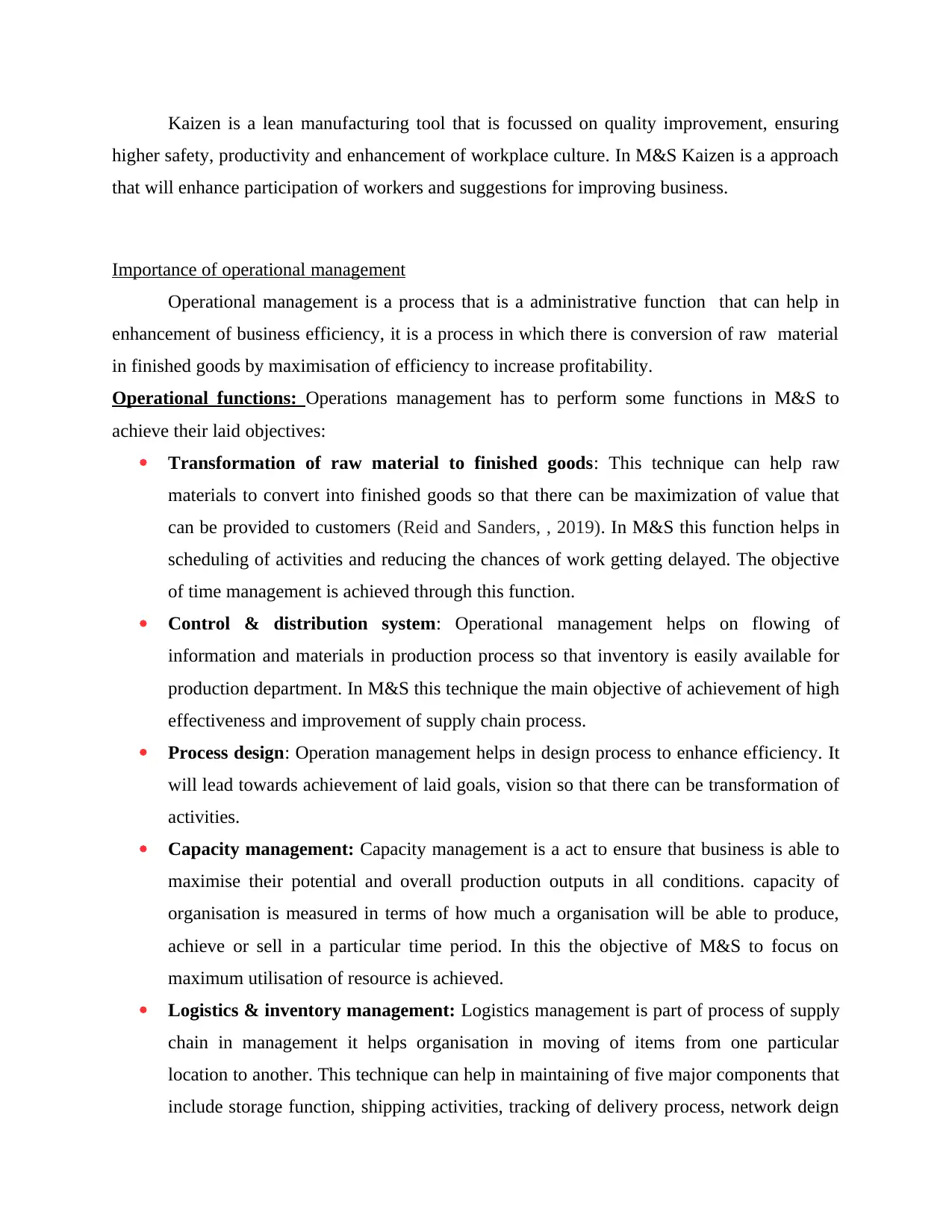
Kaizen is a lean manufacturing tool that is focussed on quality improvement, ensuring
higher safety, productivity and enhancement of workplace culture. In M&S Kaizen is a approach
that will enhance participation of workers and suggestions for improving business.
Importance of operational management
Operational management is a process that is a administrative function that can help in
enhancement of business efficiency, it is a process in which there is conversion of raw material
in finished goods by maximisation of efficiency to increase profitability.
Operational functions: Operations management has to perform some functions in M&S to
achieve their laid objectives:
Transformation of raw material to finished goods: This technique can help raw
materials to convert into finished goods so that there can be maximization of value that
can be provided to customers (Reid and Sanders, , 2019). In M&S this function helps in
scheduling of activities and reducing the chances of work getting delayed. The objective
of time management is achieved through this function.
Control & distribution system: Operational management helps on flowing of
information and materials in production process so that inventory is easily available for
production department. In M&S this technique the main objective of achievement of high
effectiveness and improvement of supply chain process.
Process design: Operation management helps in design process to enhance efficiency. It
will lead towards achievement of laid goals, vision so that there can be transformation of
activities.
Capacity management: Capacity management is a act to ensure that business is able to
maximise their potential and overall production outputs in all conditions. capacity of
organisation is measured in terms of how much a organisation will be able to produce,
achieve or sell in a particular time period. In this the objective of M&S to focus on
maximum utilisation of resource is achieved.
Logistics & inventory management: Logistics management is part of process of supply
chain in management it helps organisation in moving of items from one particular
location to another. This technique can help in maintaining of five major components that
include storage function, shipping activities, tracking of delivery process, network deign
higher safety, productivity and enhancement of workplace culture. In M&S Kaizen is a approach
that will enhance participation of workers and suggestions for improving business.
Importance of operational management
Operational management is a process that is a administrative function that can help in
enhancement of business efficiency, it is a process in which there is conversion of raw material
in finished goods by maximisation of efficiency to increase profitability.
Operational functions: Operations management has to perform some functions in M&S to
achieve their laid objectives:
Transformation of raw material to finished goods: This technique can help raw
materials to convert into finished goods so that there can be maximization of value that
can be provided to customers (Reid and Sanders, , 2019). In M&S this function helps in
scheduling of activities and reducing the chances of work getting delayed. The objective
of time management is achieved through this function.
Control & distribution system: Operational management helps on flowing of
information and materials in production process so that inventory is easily available for
production department. In M&S this technique the main objective of achievement of high
effectiveness and improvement of supply chain process.
Process design: Operation management helps in design process to enhance efficiency. It
will lead towards achievement of laid goals, vision so that there can be transformation of
activities.
Capacity management: Capacity management is a act to ensure that business is able to
maximise their potential and overall production outputs in all conditions. capacity of
organisation is measured in terms of how much a organisation will be able to produce,
achieve or sell in a particular time period. In this the objective of M&S to focus on
maximum utilisation of resource is achieved.
Logistics & inventory management: Logistics management is part of process of supply
chain in management it helps organisation in moving of items from one particular
location to another. This technique can help in maintaining of five major components that
include storage function, shipping activities, tracking of delivery process, network deign
⊘ This is a preview!⊘
Do you want full access?
Subscribe today to unlock all pages.

Trusted by 1+ million students worldwide
1 out of 18
Related Documents
Your All-in-One AI-Powered Toolkit for Academic Success.
+13062052269
info@desklib.com
Available 24*7 on WhatsApp / Email
![[object Object]](/_next/static/media/star-bottom.7253800d.svg)
Unlock your academic potential
Copyright © 2020–2025 A2Z Services. All Rights Reserved. Developed and managed by ZUCOL.





